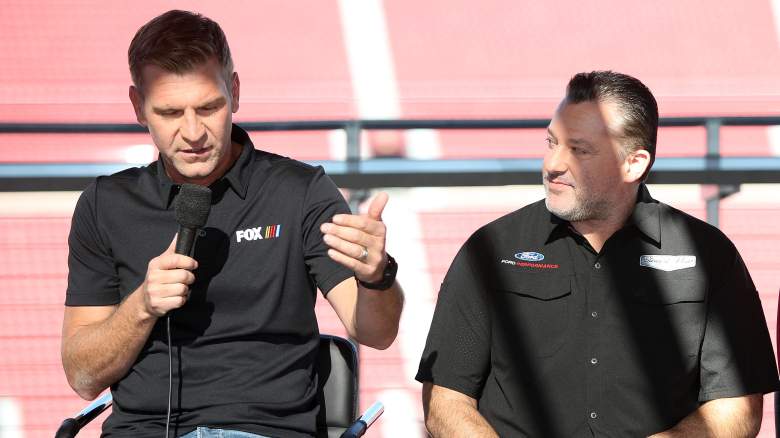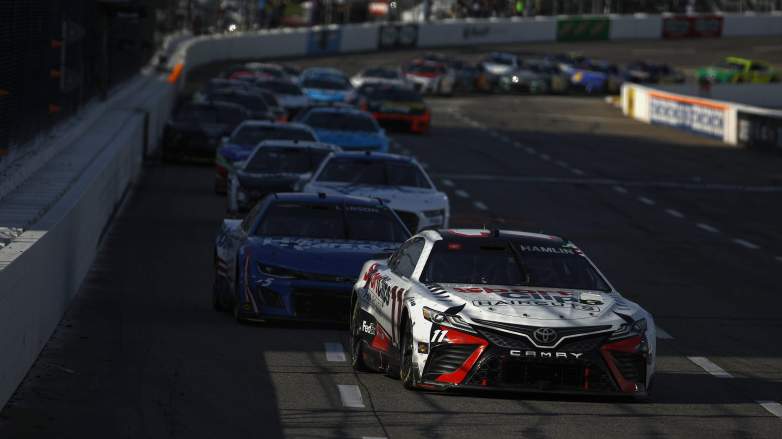
Getty Clint Bowyer (left) has made comments about NASCAR's short track package.
The NOCO 400 at Martinsville Speedway on April 16 left people in the racing industry searching for a better short track product once again. Clint Bowyer, in particular, made his opinions very clear with a candid message.
The NASCAR on FOX analyst took to Twitter on April 17 to address the Martinsville-sized elephant in the room. He said that the “short track program sucks” and that it is unacceptable. Though Bowyer also expressed optimism about NASCAR’s ability to address the problem moving forward with the season.
Bowyer is one of the many drivers — active or retired — that weighed in about the racing at Martinsville Speedway. Denny Hamlin called the package terrible while Aric Almirola said that the short track is now all about track position.
Joey Logano finished second behind Kyle Larson and then said that NASCAR probably has to go back to the drawing board because the cars all run the same speed. He said that there needs to be a speed differential throughout the field.
The sanctioning body did make some adjustments ahead of the 2023 Cup Series season. NASCAR implemented a new short track package that has a 30 percent lower downforce. This helped the racing at Richmond, and it slightly improved the product at Martinsville Speedway. Though the race with limited passes for the lead still left much to be desired.
Denny Hamlin Has Advocated for Higher Horsepower Numbers

GettyDenny Hamlin (front) has been vocal about the short track issues.
Is the problem at short tracks the result of the size of the spoiler, the ability to shift, the tire compound, or some other factor? There are varying opinions about this topic. Though Denny Hamlin has been vocal while advocating for higher horsepower numbers.
“At this point, I don’t know if it’s the aero package or not,” Hamlin said on the April 17 episode of his podcast. “I think it’s a grip, horsepower problem. I’ll say that because I remember doing tests about 10-12 years ago when we were running 900 horsepower, 950 really. We were up there.
“They kept playing around with tapered spacers, like, ‘All right, we’re going to cut the horsepower down’ at whatever track we were testing at. And I noticed for every 50 horsepower that they took out of the car — we kept trying all of these different plates and they kept choking the horsepower down more, and more, and more. The long run was two-tenths faster every time they started taking horsepower away.”
As Hamlin continued to explain, the cars at this test roughly a decade ago did not have enough horsepower to burn through the tires. He said that the drivers were able to maintain similar lap times longer in the run than they could with the higher horsepower.
The driver of the No. 11 Joe Gibbs Racing did not simply talk about problems that plague the short tracks. He also presented another important factor that could support better racing.
Hamlin’s main point was that the drivers need more horsepower at short tracks. He also indicated that different tires could improve the product on NASCAR’s short tracks.
Hamlin explained that Goodyear has smart people capable of designing a tire compound that will have a considerable amount of fall-off. This will only force drivers to make big decisions about whether to save their tires or push for positions.
Engine Changes Are Less Likely After Martinsville 1

GettyAlex Bowman (front) races at Martinsville Speedway.
There are some ways that NASCAR could fix the short track product and produce better passing opportunities. However, implementing a fix will not be a simple matter due to the turnaround time.
Hendrick Motorsports President and GM Jeff Andrews provided insight into the matter after Kyle Larson won for the first time at Martinsville Speedway. He used his knowledge of engines to explain how going to a higher horsepower engine would be possible. Though this decision would have to be made in the next few days in order to offset the time required to order parts.
“We are, I would say, five to six months out on parts, orders, and deliveries,” Andrews said after the NOCO 400. “Really when you get to this part of the season, you start to consume a lot of sealed engines that you have run earlier in the season.
“So it gets complicated just to try to change a package over or change a power level over because these engines are built and tuned and all the analysis and everything that’s run on them is for the current power level. So when you start to make changes to that, it requires changes to a lot of parts and pieces. And some of those would be as much as a year to possibly 18 months lead time to get that work done and get parts ordered.”
The sealed engines that Andrews referenced are part of the Cup Series rules packages. Each team has a rotation of sealed engines that they must use in multiple events. This is supposed to help cut down on engine costs, but it also stands in the way of potential horsepower changes ahead of the return to Martinsville in October.